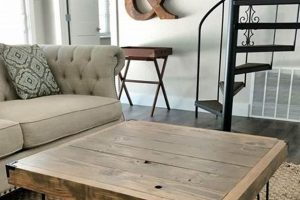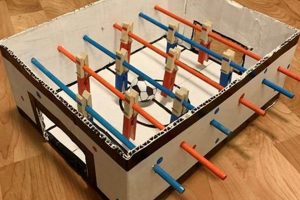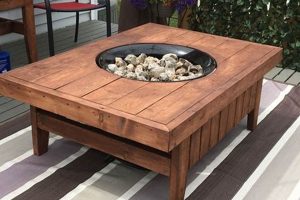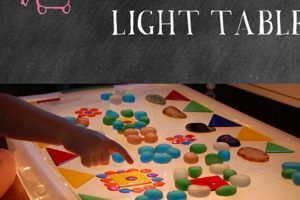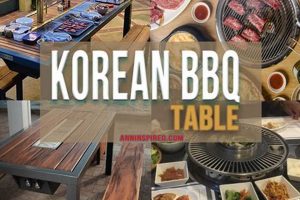A self-constructed furnishing featuring a surface composed of cement-based composite material. It represents a project undertaken by individuals to create a customized piece of furniture for indoor or outdoor use. As an example, a homeowner might construct a support frame from wood or metal and then cast a concrete slab to serve as the tabletop.
This construction method offers several advantages, including cost-effectiveness compared to purchasing pre-made concrete furniture and the ability to tailor dimensions and aesthetics to specific needs. Historically, the application of concrete in furniture design has evolved from solely utilitarian purposes to incorporate decorative and artistic elements, reflecting a growing interest in industrial and modern design styles. The durable and robust nature of the material ensures longevity and resistance to weathering, making it suitable for both indoor and outdoor environments.
The subsequent discussion will delve into the processes involved in constructing such a furnishing, including mold creation, concrete mixing and pouring techniques, curing procedures, and finishing options. Further consideration will be given to material selection, safety precautions, and design considerations to ensure a successful and aesthetically pleasing outcome.
Tips for Achieving a Successful Concrete Tabletop
The creation of a concrete tabletop demands careful planning and execution. The following guidance provides essential considerations for achieving a durable and aesthetically pleasing result.
Tip 1: Mold Preparation is Paramount: A well-constructed and properly sealed mold is crucial. Any imperfections in the mold will be reflected in the final concrete surface. Use melamine-coated wood for easy release and ensure all seams are meticulously sealed with silicone caulk.
Tip 2: Reinforcement Enhances Durability: Integrate a reinforcement layer, such as wire mesh or rebar, within the concrete. This significantly increases the tabletop’s tensile strength and resistance to cracking, particularly for larger surfaces.
Tip 3: Precise Concrete Mixing is Essential: Adhere strictly to the manufacturer’s recommended water-to-cement ratio. Overwatering weakens the concrete, while insufficient water inhibits proper hydration. Employ a concrete mixer for uniform consistency.
Tip 4: Vibration Eliminates Air Pockets: After pouring the concrete into the mold, vibrate it thoroughly using a rubber mallet or orbital sander without sandpaper. This process forces trapped air bubbles to the surface, resulting in a denser and stronger finished product.
Tip 5: Controlled Curing Promotes Strength: Maintain a moist environment during the curing process, which typically lasts for seven to ten days. Cover the concrete with plastic sheeting and periodically mist it with water. This prevents premature drying and promotes optimal hydration.
Tip 6: Surface Finishing Enhances Aesthetics: Once fully cured, grind the concrete surface to achieve the desired level of smoothness and expose the aggregate, if desired. Utilize progressively finer grit diamond polishing pads, working from coarse to fine.
Tip 7: Sealing Protects Against Stains: Apply a high-quality concrete sealer to protect the surface from stains and water damage. Choose a sealer appropriate for the intended use, considering factors such as food safety and UV resistance. Multiple coats may be necessary.
By adhering to these guidelines, individuals can significantly improve the likelihood of creating a durable and visually appealing concrete tabletop, adding a unique and personalized element to their living space.
The subsequent section will explore common challenges encountered during the construction process and provide troubleshooting solutions.
1. Material Selection
The selection of materials for a self-constructed cement-based tabletop significantly influences its structural integrity, aesthetic qualities, and longevity. The choice of cement type, aggregate composition, and reinforcement material dictates the finished product’s resistance to cracking, staining, and environmental degradation. Inadequate material selection results in a compromised structure susceptible to premature failure. For instance, using a standard Portland cement without appropriate additives in regions experiencing freeze-thaw cycles leads to cracking and surface deterioration. Similarly, choosing an aggregate with high porosity increases the likelihood of staining and water absorption.
Considerations regarding material compatibility are also paramount. The chemical interaction between the cement and aggregate must be carefully evaluated to prevent adverse reactions that weaken the concrete matrix. For example, certain types of aggregates containing reactive silica can react with alkalis in the cement, leading to expansive stresses and cracking. The type and placement of reinforcement are critical as well. While steel rebar provides substantial tensile strength, it is prone to corrosion if not properly encased in concrete. Fiber reinforcement, such as polypropylene or glass fibers, can offer an alternative, corrosion-resistant option, particularly for thinner tabletops.
Therefore, thorough research and informed decision-making regarding material selection are essential prerequisites for a successful cement-based tabletop construction. Understanding the properties of various cement types, aggregate options, and reinforcement materials enables individuals to optimize the finished product’s performance and aesthetic characteristics, resulting in a durable and visually appealing furnishing. The long-term stability and appearance of the table are directly linked to judicious selection processes applied at the outset.
2. Mold Construction
Mold construction represents a critical phase in the fabrication of cement-based tabletops, directly influencing the final dimensions, surface finish, and overall structural integrity. Precise mold fabrication is not merely a preparatory step but an integral component that determines the quality and feasibility of the final product.
- Material Selection for Mold Integrity
The choice of mold material dictates its durability, ease of release, and surface texture imparted to the concrete. Melamine-laminated particleboard is frequently used for its smooth, non-porous surface and ease of disassembly. However, for complex shapes or repeated use, fiberglass or steel molds offer greater resilience and dimensional stability. The selected material must withstand the pressure exerted by the wet concrete without deformation, ensuring the finished tabletop maintains its intended shape.
- Sealing and Reinforcement Against Leakage and Distortion
Thorough sealing of mold seams is crucial to prevent concrete slurry from leaking, which can result in unsightly blemishes and weakened edges. Silicone caulk is typically employed to create a watertight seal. Furthermore, reinforcing the mold, particularly for larger tabletops, with external bracing or a supporting frame prevents bowing or warping under the weight of the concrete. Inadequate reinforcement compromises the tabletop’s flatness and structural integrity.
- Releasing Agents for Clean Separation
The application of a releasing agent, such as vegetable oil or a commercial mold release compound, facilitates the separation of the hardened concrete from the mold. This prevents damage to the concrete surface during demolding and prolongs the lifespan of the mold. Improper or insufficient application of releasing agents leads to adhesion between the concrete and the mold, necessitating forceful separation that can chip or crack the tabletop’s edges.
- Incorporating Design Elements within the Mold
The mold provides an opportunity to integrate decorative elements into the concrete surface. Molds can be designed to create recessed areas for inlays, textured surfaces, or custom edge profiles. Accurate placement of these elements within the mold is essential to achieving the desired aesthetic outcome. Errors in placement or securing these elements result in misaligned or distorted design features in the finished tabletop.
These considerations underscore the fundamental connection between mold construction and the successful creation of a durable and aesthetically pleasing cement-based tabletop. Adherence to best practices in mold fabrication directly translates to a higher-quality finished product, reducing the likelihood of defects and enhancing the tabletop’s overall longevity and visual appeal. Careful attention to mold construction saves time and resources and ultimately dictates the feasibility of achieving desired functional and aesthetic design goals.
3. Reinforcement Placement
The successful construction of a self-made cement-based tabletop relies significantly on the strategic implementation of reinforcement. Concrete, while exhibiting considerable compressive strength, demonstrates limited tensile strength. Without adequate reinforcement, a tabletop, particularly one of substantial size, is prone to cracking under its own weight or when subjected to external loads. Reinforcement placement addresses this inherent weakness by integrating materials capable of withstanding tensile forces within the concrete matrix. The effect is a composite structure that distributes stress more effectively, enhancing overall durability.
Various methods exist for reinforcing concrete tabletops, each influencing the final product differently. Wire mesh, for instance, offers distributed reinforcement, mitigating surface cracking commonly caused by shrinkage during the curing process. Steel rebar, providing more substantial tensile strength, is suitable for larger tabletops or those intended to bear significant weight. The placement of reinforcement within the concrete layer is critical. Ideally, it should be positioned within the lower third of the slab, where tensile stresses are most concentrated. Insufficient concrete cover over the reinforcement can lead to corrosion, compromising the structure’s long-term integrity. Conversely, placing reinforcement too close to the surface reduces its effectiveness in resisting bending forces. Real-world examples illustrate these principles: a tabletop with improperly positioned reinforcement may exhibit cracks along its edges, while one lacking reinforcement altogether may fracture completely under moderate stress.
Effective reinforcement placement is a cornerstone of the fabrication process. A well-reinforced concrete tabletop ensures longevity and stability, preventing premature failure and maintaining its structural integrity over time. Challenges associated with reinforcement placement, such as ensuring proper cover and avoiding displacement during the pouring process, can be mitigated through careful planning and execution. Ultimately, a thorough understanding of reinforcement principles, coupled with meticulous application, contributes to the creation of a functional and aesthetically pleasing cement-based tabletop.
4. Mixing Consistency
Achieving a uniform and appropriate consistency in the concrete mix is paramount for the structural integrity and aesthetic outcome of a self-constructed cement-based tabletop. Variations in the mix’s water-to-cement ratio, aggregate distribution, and overall homogeneity directly influence the concrete’s workability, strength, and surface finish. An improperly mixed batch compromises the material’s ability to bond effectively, leading to potential cracking, crumbling, or an unsatisfactory surface appearance.
- Water-Cement Ratio and Strength
The ratio of water to cement is a critical determinant of concrete strength. Excess water weakens the cement matrix, leading to a porous and less durable structure. Insufficient water, conversely, hinders proper hydration, resulting in a mix that is difficult to work with and fails to achieve its potential strength. A tabletop constructed with an imbalanced water-cement ratio is prone to cracking, reduced load-bearing capacity, and increased susceptibility to environmental damage. An example of this is when too much water is used, then the concrete will crack when drying.
- Aggregate Distribution and Workability
Uniform distribution of aggregate comprising both fine and coarse particles ensures a dense and stable concrete matrix. Segregation of aggregate, where larger particles settle and finer particles concentrate near the surface, results in weak points and inconsistencies in the concrete’s texture. A properly proportioned and mixed aggregate blend facilitates workability, allowing the concrete to flow smoothly into the mold, filling all corners and crevices without excessive vibration. If the aggregates are distributed poorly, then the entire concrete would not be durable.
- Homogeneity and Surface Finish
A homogenous mix, where all components are thoroughly and evenly distributed, is essential for achieving a smooth and consistent surface finish. Lumps of unmixed cement or pockets of segregated aggregate create blemishes and imperfections on the tabletop’s surface. The absence of homogeneity leads to a visually unappealing result that requires extensive grinding and polishing to rectify. Uneven surface will create issues to the surface finish
- Mixing Time and Equipment
Adequate mixing time, using appropriate equipment such as a concrete mixer, is crucial for ensuring a homogenous and workable mix. Insufficient mixing leaves pockets of unhydrated cement and poorly distributed aggregate. Overmixing, conversely, can lead to air entrainment and a weakened concrete structure. Employing the correct mixing technique and duration ensures that all components are thoroughly combined, optimizing the concrete’s properties for tabletop construction. If mixing time is not controlled, then the concrete will not be durable.
The preceding facets highlight the interconnectedness of mixing consistency and the creation of a successful cement-based tabletop. Adherence to established best practices in concrete mixing, including precise measurement of ingredients, thorough blending, and appropriate mixing duration, is vital for achieving a durable, aesthetically pleasing, and structurally sound finished product. These careful practices must be done, or else, the surface might be in poor condition.
5. Curing Duration
Curing duration represents a critical and often underestimated aspect of cement-based tabletop construction. The hydration process, by which cement gains strength and durability, is time-dependent. Insufficient curing leads to a weaker, more porous concrete matrix, directly impacting the tabletop’s longevity and resistance to wear. Therefore, appropriate attention to curing protocols is essential for realizing a structurally sound and visually appealing final product.
- Hydration Process and Strength Development
The chemical reaction between cement and water, known as hydration, is responsible for the hardening and strengthening of concrete. This process continues over an extended period, with the most significant strength gains occurring within the first 7-28 days. Premature drying interrupts hydration, hindering the development of optimal compressive and tensile strength. A cement-based tabletop that has not undergone sufficient curing is susceptible to cracking, chipping, and reduced load-bearing capacity. An example of this is the outside of tabletop getting dried before the inside of tabletop has properly hardened.
- Moisture Retention and Cracking Prevention
Maintaining a moist environment during the curing period is crucial for preventing rapid evaporation, which leads to shrinkage and cracking. Covering the concrete surface with plastic sheeting or periodically misting it with water helps retain moisture and promotes uniform hydration throughout the material. Failure to adequately control moisture loss results in surface crazing and internal stresses that compromise the tabletop’s structural integrity. For example, the tabletop might form small cracks on the surface, which in turn would cause the tabletop to break much easier.
- Temperature Control and Hydration Rate
Temperature significantly influences the rate of hydration. Colder temperatures slow down the process, requiring extended curing durations, while excessively high temperatures accelerate evaporation and can lead to thermal cracking. Maintaining a consistent temperature range during curing optimizes hydration and minimizes the risk of temperature-related defects. Concrete cured in excessively cold conditions is prone to developing lower strength than intended and thus, will cause the table to be brittle and easily broken.
- Influence of Cement Type and Additives
The type of cement used in the mix affects the required curing duration. Some cement types, such as rapid-hardening cement, achieve their design strength more quickly than others. The inclusion of additives, such as pozzolans or fly ash, can also influence the hydration process and necessitate adjustments to the curing regime. Careful consideration of cement type and additive composition is essential for establishing an appropriate curing schedule. For example, the manufacturer’s instruction should be followed to determine the length and environment of curing process
In summary, the curing duration is not merely a procedural step but a critical variable affecting the performance and aesthetics of the finished cement-based tabletop. By understanding the underlying principles of hydration, moisture retention, and temperature control, and by tailoring the curing process to the specific materials used, individuals can ensure a durable, visually appealing, and long-lasting addition to their living space. Correct Curing Duration allows the DIY Concrete Top Table to be a worthwhile addition to the home.
6. Surface Finishing
Surface finishing operations represent a crucial stage in the creation of a cement-based tabletop, significantly influencing its aesthetic appeal, tactile properties, and resistance to staining. These processes transform the raw, often uneven concrete surface into a refined and functional element of furniture.
- Grinding for Smoothness and Aggregate Exposure
Grinding employs abrasive tools to remove the surface layer of concrete, revealing the underlying aggregate and creating a smooth, uniform plane. The degree of grinding determines the level of aggregate exposure, ranging from a subtle hint to a fully exposed aggregate surface. This process requires careful control to avoid over-grinding, which can weaken the concrete matrix and create an uneven texture. For example, a progressive grinding approach, utilizing increasingly finer grit diamond pads, is essential to attain a polished and visually appealing finish.
- Polishing for Enhanced Luster and Durability
Polishing follows grinding, utilizing even finer abrasive pads to impart a glossy sheen to the concrete surface. This process densifies the surface, increasing its resistance to staining and wear. Polishing enhances the natural color and texture of the concrete, creating a more visually engaging and durable surface. Achieving a high-gloss finish requires specialized equipment and techniques, but the result is a surface that is both aesthetically pleasing and functionally superior.
- Sealing for Stain Resistance and Protection
Sealing involves the application of a protective coating to the concrete surface, preventing the penetration of liquids and contaminants that can cause staining and damage. Various types of sealers are available, each offering different levels of protection and aesthetic effects. Penetrating sealers soak into the concrete, providing a natural look while repelling liquids, while topical sealers form a protective film on the surface, offering enhanced stain resistance and gloss. The choice of sealer depends on the intended use of the tabletop and the desired aesthetic outcome. Applying a sealant to the tabletop will avoid staining from common household items.
- Texturing for Tactile and Visual Interest
Texturing techniques can be employed to create a tactile surface, adding visual interest and enhancing slip resistance. These techniques range from simple broom finishes to more elaborate acid etching or sandblasting. Texturing can be used to create a rustic or industrial aesthetic, complementing the raw character of concrete. The choice of texturing technique should be carefully considered, as it affects both the visual appearance and the functional properties of the tabletop.
The application of surface finishing techniques transforms the inherent characteristics of concrete, turning a simple slab into a durable and aesthetically refined tabletop. Each technique contributes uniquely to the final product, impacting its appearance, texture, and performance. Mastery of these processes is essential for realizing the full potential of a cement-based tabletop.
7. Sealer Application
The application of sealers to self-constructed cement-based tabletops is an indispensable step in ensuring their long-term durability, functionality, and aesthetic preservation. Sealers mitigate the inherent porosity of concrete, preventing the ingress of liquids and contaminants that can cause staining, cracking, and overall deterioration. The correct selection and application of a suitable sealer directly influence the service life and maintenance requirements of the finished product.
- Protection Against Staining and Liquid Penetration
Concrete’s porous nature renders it susceptible to staining from common household liquids such as oils, acids, and beverages. Sealer application creates a barrier that prevents these substances from penetrating the surface, thus preserving the tabletop’s appearance. The type of sealer used significantly impacts its effectiveness against different types of stains. For example, an acrylic sealer might offer adequate protection against water-based stains, while a more robust epoxy sealer is better suited for resisting oil-based contaminants. Real-world scenarios demonstrate that an unsealed concrete tabletop is prone to permanent discoloration and damage from everyday spills, necessitating costly repairs or replacement.
- Enhancement of Durability and Freeze-Thaw Resistance
In environments subject to freeze-thaw cycles, water absorbed into the concrete can expand upon freezing, causing internal stresses that lead to cracking and surface spalling. Sealer application reduces water absorption, thereby minimizing the risk of freeze-thaw damage. This is particularly crucial for outdoor concrete tabletops exposed to harsh weather conditions. The selection of a sealer with appropriate freeze-thaw resistance is essential for ensuring the longevity of the structure. An unsealed concrete tabletop in a cold climate will likely exhibit signs of deterioration within a few years, whereas a properly sealed surface can withstand decades of exposure.
- Control of Surface Appearance and Texture
Sealers can alter the visual characteristics of a concrete tabletop, enhancing its natural color and texture or imparting a glossy or matte finish. Some sealers contain pigments or dyes that can be used to customize the tabletop’s appearance. The choice of sealer allows individuals to tailor the finished product to their aesthetic preferences. For example, a penetrating sealer preserves the natural look of the concrete while providing protection, while a topical sealer creates a more polished and reflective surface. The application of different sealers can drastically transform the visual impact of the completed tabletop.
- Mitigation of Dusting and Alkali-Silica Reaction
Sealers can help to mitigate dusting, a phenomenon where fine particles of cement are released from the concrete surface. They also can provide a barrier against alkali-silica reaction (ASR), a chemical process that can cause expansive cracking in concrete. By penetrating the surface and binding loose particles or by blocking the ingress of moisture necessary for ASR, sealers contribute to the long-term stability and integrity of the tabletop. Dusting can make the table unusable, while ASR will crack the table.
In conclusion, the judicious selection and application of a suitable sealer are integral to the creation of a durable, functional, and aesthetically pleasing self-constructed cement-based tabletop. The benefits of sealer application extend beyond mere aesthetic enhancement, encompassing essential aspects of structural integrity and resistance to environmental degradation. Neglecting this step can significantly reduce the lifespan and usability of the finished product, rendering the entire construction effort less sustainable. Therefore, it’s important to consider how you will seal your table for it to function and protect it properly.
Frequently Asked Questions
This section addresses common inquiries regarding the fabrication of cement-based tabletops, providing concise and informative responses to frequently encountered questions.
Question 1: What is the optimal concrete mix design for a tabletop application?
The precise composition of the concrete mix is a function of several factors, including desired strength, workability, and aesthetic considerations. A typical mix comprises Portland cement, fine aggregate (sand), coarse aggregate (gravel or crushed stone), and water. The water-cement ratio should be carefully controlled to optimize strength and minimize cracking. Admixtures, such as plasticizers or air-entraining agents, may be added to enhance workability or freeze-thaw resistance.
Question 2: What is the recommended thickness for a concrete tabletop?
The appropriate thickness depends on the dimensions of the tabletop and the intended load it will bear. As a general guideline, a thickness of 1.5 to 2 inches is suitable for smaller tabletops (e.g., coffee tables or side tables), while larger dining tables may require a thickness of 2.5 to 3 inches to ensure adequate structural support. Reinforcement with wire mesh or rebar is essential for preventing cracking, especially in thinner tabletops.
Question 3: How long should a concrete tabletop cure before use?
Concrete strength develops over time through the process of hydration. While the concrete may appear to be solid after a few days, it continues to gain strength for several weeks. It is generally recommended to allow a concrete tabletop to cure for at least 7 days before demolding, and for a full 28 days before subjecting it to significant loads. Maintaining a moist environment during the curing period promotes optimal hydration and minimizes cracking.
Question 4: What type of sealer is best for a concrete tabletop?
The selection of a sealer depends on the intended use of the tabletop and the desired aesthetic outcome. Penetrating sealers, such as silanes or siloxanes, provide excellent protection against water and oil-based stains while preserving the natural look of the concrete. Topical sealers, such as acrylics or epoxies, offer enhanced stain resistance and can create a glossy or matte finish. It is essential to choose a sealer specifically designed for concrete surfaces and to follow the manufacturer’s instructions for application.
Question 5: How can air bubbles be minimized in a concrete tabletop?
Air bubbles can create unsightly voids in the surface of a concrete tabletop. To minimize air entrapment, it is essential to thoroughly vibrate the concrete after pouring it into the mold. This can be accomplished using a rubber mallet or an orbital sander (without sandpaper). Adding a plasticizer to the concrete mix can also improve its flowability and reduce the likelihood of air bubbles forming.
Question 6: How can cracking be prevented in a concrete tabletop?
Cracking is a common concern in concrete construction. Several factors contribute to cracking, including improper mix design, inadequate reinforcement, and rapid drying. To minimize cracking, it is essential to use a properly proportioned concrete mix, reinforce the tabletop with wire mesh or rebar, and maintain a moist environment during the curing process. Avoid placing the tabletop in direct sunlight or exposing it to extreme temperature fluctuations during curing.
These FAQs offer a starting point for understanding the key considerations in concrete tabletop construction. Careful planning, attention to detail, and adherence to best practices are essential for achieving a successful outcome.
The subsequent section will provide a step-by-step guide to constructing a basic concrete tabletop.
DIY Concrete Top Table
The preceding exploration has detailed critical aspects of cement-based tabletop construction, from material selection and mold fabrication to reinforcement placement, mixing consistency, curing duration, surface finishing, and sealer application. Each stage directly influences the final product’s structural integrity, aesthetic characteristics, and longevity. Proper execution of these techniques is paramount to achieving a successful outcome.
The creation of a durable and visually appealing furnishing from cementitious materials requires diligent planning and meticulous execution. The information presented serves as a foundational resource for those undertaking such a project. It is incumbent upon the constructor to adhere to established best practices and safety protocols, ensuring both the quality of the finished product and the safety of the construction process. The successful implementation of these techniques will enable the creation of a unique and enduring piece of furniture.


